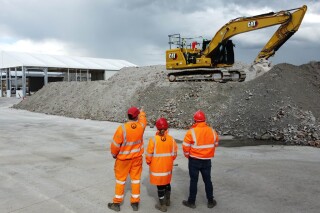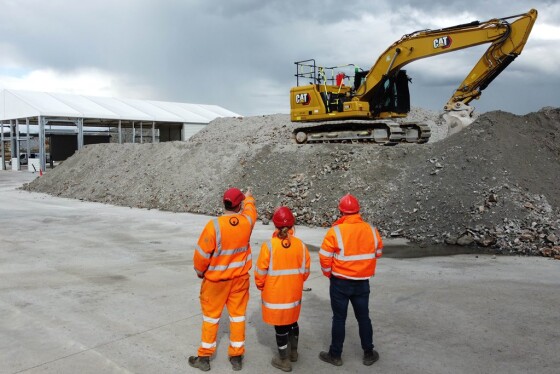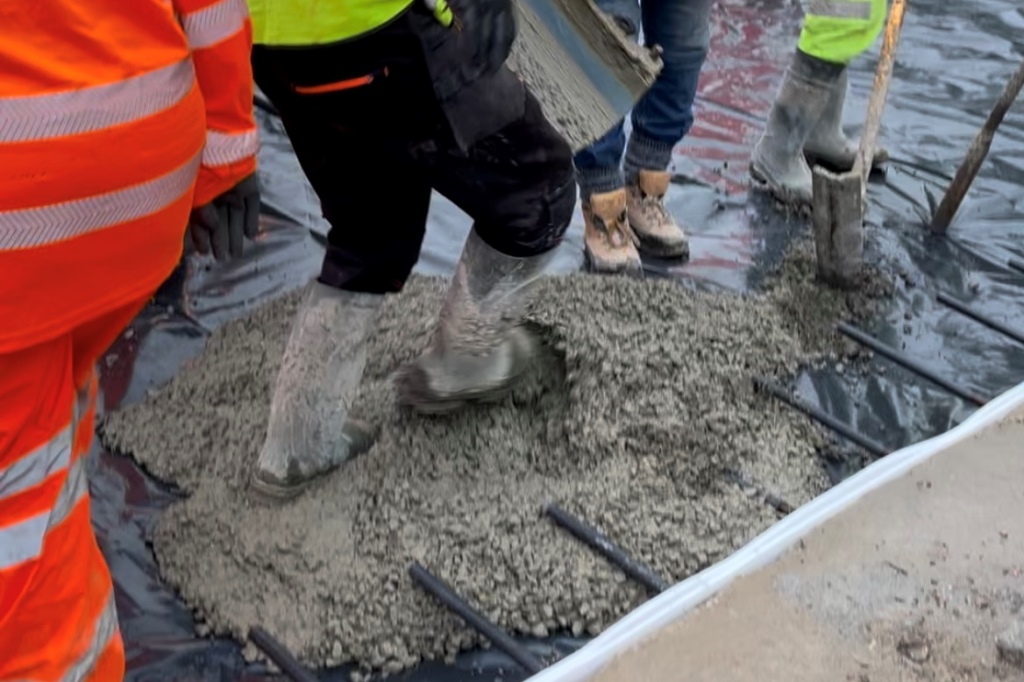Waste recycling specialist Recycl8 and construction materials company Breedon have joined forces to lay the first-ever incinerator bottom ash aggregate (IBAA) R8 concrete in the UK at Veolia’s Ling Hall site near Rugby.
The IBAA/R8 concrete mix has been laid on the extension pad at Veolia Ling Hall by Chesterfield-based civils contractor TG Beighton. The initiative was undertaken with permission from the Environment Agency as part of a research and development project.
As previously reported, Veolia began processing incinerator bottom ash (IBA) at Ling Hall last year in joint venture with Danish company Meldgaard Recycling, processing waste from the nearby Battlefield waste-to-energy incinerator to produce 50,000 tonnes of secondary aggregates a year. This material is managed by Meldgaard and combined with a Breedon low carbon concrete mix and Recycl8’s R8 Mix to deliver a high-performance, lower-carbon alternative to traditional concrete.
While IBAA is widely used in civil engineering projects under the Regulatory Position Statement (RPS) protocol, this project is seen as a step-change in proving IBAA’s viability in concrete production, and in providing a sustainable and performance-driven alternative to virgin aggregates.
Designed to enhance the performance of IBAA in concrete, the R8 Mix provides an option for construction companies looking to reduce their carbon footprint, as each tonne of IBA derived material saves around 30kg of CO2 emissions. Recycl8’s expertise in repurposing industrial waste into valuable construction materials ensures that the concrete is both environmentally sound and meets the rigorous performance demands of modern infrastructure projects.
Veolia UK chief operating officer Donald Macphail said: “To lower carbon emissions, and advance progress on the net zero targets, industry is rightly looking for new ways to lower the carbon footprint associated with construction. To support this aim it’s essential to deliver materials and solutions that can lower environmental impact, and this latest innovation is a clear example of how we can provide new sustainable alternatives.
By processing bottom ash, from the treatment of non-recyclable waste, we can deliver an important source of secondary aggregates for the 90 million tonnes of concrete used annually in the UK, lower the dependence on virgin resources, and reduce carbon emissions”


Recycl8 managing director Mark Gillespie said “This is a powerful example of how industrial by-products, when combined with cutting-edge R8 Mix products, can drive the construction industry toward a greener future. The Veolia Ling Hall extension pad project demonstrates the versatility and strength of IBAA/R8 Mix concrete in real-world applications, showcasing a true circular economy offering. With the support of the EA, this initiative sets the stage for further testing and validation, paving the way for IBAA to become a like-for-like alternative to part-replace virgin aggregate in concrete production.”
Breedon regional manager Nick Farrell added: “Collaborating on this project has allowed us to test a product that could truly change the game for sustainable construction. The IBAA/R8 Mix concrete which we designed and developed not only reduces the reliance on traditional materials, but also offers a high-performance recycled low carbon solution for the industry.”
Meldgaard UK manager Sarah Lakin said: “We continuously seek innovative ways to repurpose IBAA, a by-product of the energy-from-waste process. We’ve long seen the potential of IBAA, and combined with the R8 mix, we are confident that this material can play a key role in creating more sustainable, low-carbon construction solutions. We are very grateful to Veolia for affording us this unique opportunity to demonstrate the viability of our solution.”

